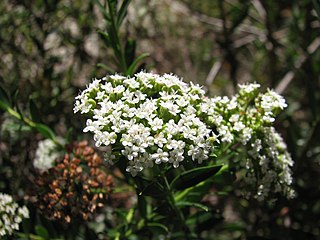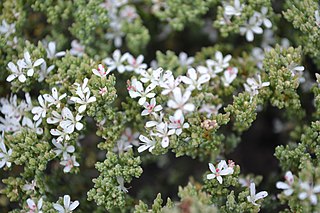
Gastrolobium is a genus of flowering plants in the family Fabaceae. There are over 100 species in this genus, and all but two are native to the south west region of Western Australia.

Nikolai Stepanovich Turczaninow was a Russian botanist and plant collector who first identified several genera, and many species, of plants.

Platysace is a genus of about 22 species of woody perennial herbs, shrubs and subshrubs in the family Apiaceae, and is endemic to Australia. The flowers are borne on the ends of branches in a compound umbel and are bisexual or male with white, cream-coloured or pinkish flowers.

Amyris is a genus of flowering plants in the citrus family, Rutaceae. The generic name is derived from the Greek word αμυρων, which means "intensely scented" and refers to the strong odor of the resin. Members of the genus are commonly known as torchwoods because of their highly flammable wood.
Zinowiewia is a genus of flowering plants in the family Celastraceae. It includes 14 species native to the tropical Americas, ranging from northeastern Mexico to French Guiana and Bolivia.
Dictamnus is a genus of flowering plant in the family Rutaceae, native to temperate Eurasia from Spain to China. The genus was first described by Carl Linnaeus in 1753.
Endocellion is a small genus of flowering plants in the daisy family Asteraceae.

Ceratogyne is a genus of flowering plants in the family Asteraceae.
Geleznowia is a small genus of flowering plants in the family Rutaceae.

Rinzia is a genus of flowering plants in the family Myrtaceae. The genus was first formally described in 1843 and reinstated and revised in 1986.

Frankenia is the only genus in the Frankeniaceae family of flowering plants. Other genera have been recognized within the family, such as Anthobryum, Hypericopsis and Niederleinia, but molecular phylogenetic studies have consistently shown that they all belong inside Frankenia. Frankenia comprises about 70–80 species of shrubs, subshrubs and herbaceous plants, adapted to saline and dry environments throughout temperate and subtropical regions. A few species are in cultivation as ornamental plants.

Saposhnikovia is a monotypic genus of flowering plants in the family Apiaceae. Its only species is Saposhnikovia divaricata, known as fángfēng防風 in Chinese, bangpung in Korean, and siler in English. The plant is still frequently referenced under the obsolete genus name Ledebouriella in many online sources devoted to traditional Chinese medicine. It was first described as Stenocoelium divaricatum by Nikolai Turczaninow in 1844, and transferred to Saposhnikovia in 1951.
Lophiocarpus is a genus of flowering plants belonging to the family Lophiocarpaceae.
Molopanthera is a genus of flowering plants belonging to the family Rubiaceae.
Oligomeris is a genus of flowering plants belonging to the family Resedaceae.

Phlojodicarpus is a genus of flowering plants belonging to the family Apiaceae.
Lithosciadium is a genus of flowering plants belonging to the family Apiaceae.

Zanthoxyloideae is a subfamily of the family Rutaceae.
Hansenia is a genus of flowering plant in the family Apiaceae, native to from Siberia to China. The genus was first described by Nikolai Turczaninow in 1844.









